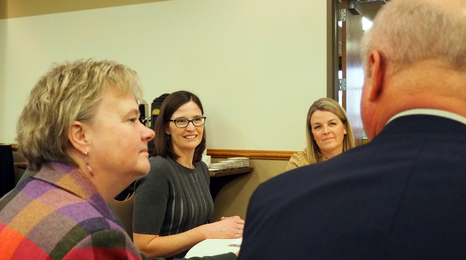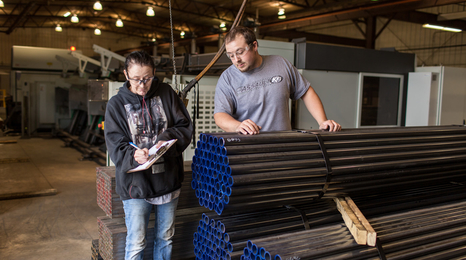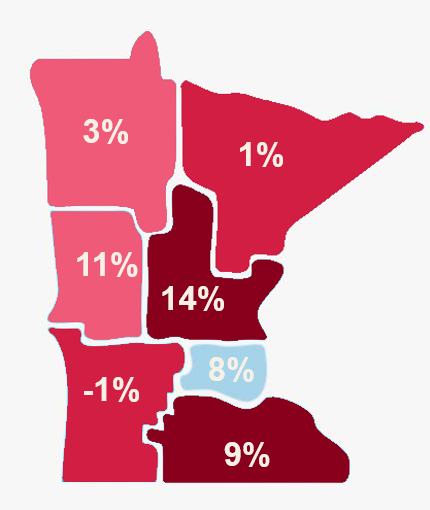"It's not your grandmother's rural economy anymore.”— Brigid Tuck
About the Greater Minnesota research study
In 2014, Extension's economic impact analyst, Brigid Tuck, took a thorough look at Greater Minnesota’s economy. She wanted to see how Greater Minnesota fared after the Great Recession. She also wanted to describe the diversity of Greater Minnesota’s economy. She emphasized that, though agriculture and mining are still important drivers, industries such as professional services, health care, tourism and more add great vitality to Greater Minnesota’s economy.
Many factors have affected Minnesota's economy over the past five years. Here are some updates.
The good news
The diversity of Greater Minnesota’s economy is a success story. Analysis points to strengths across a number of sectors – from national competitiveness in agriculture and manufacturing to impressive growth in health care and professional and business services. This diversity makes Greater Minnesota's economy quite resilient in comparison to other Midwestern states.
Tuck also emphasizes the interdependence of regional economies. "Growth in one industry can help other sectors, and a strong business mix keeps the tax burden off the back of just one industry. When communities see how important that diversity is, they can work together to support all of their local businesses."
Greater Minnesota's employment mirrors the Twin Cities*
As shown in the chart above, the economic diversity of Greater Minnesota mirrors the economic diversity of the Twin Cities. The Twin Cities has double the number of jobs in professional and business services than Greater Minnesota, but of course the Twin Cities doesn’t have agriculture or mining. The type of service jobs in Greater Minnesota is likely different than the Twin Cities', and wages may differ. Still, the employment mix in Greater Minnesota and the Twin Cities has a lot in common.
Stable agriculture prices helped Greater Minnesota's economy during the Great Recession. In 2015, however, the average farm didn’t even earn enough to cover their scheduled debt payments. Greater Minnesota’s economy diversity will help weather the economic storm faced by agriculture. Professional and business services — like accounting and payroll services — lead employment numbers. And jobs in health and social services industry are growing — not as fast as it is in other states, but it’s now the number two employer in Greater Minnesota.
About our data
*Employment data was drawn from Economic Modeling Specialists International (EMSI). Output data was calculated using IMPLAN.
EMSI data calculates employment using numbers of employees reported to the state of Minnesota yearly. EMSI data does not include agriculture labor information that is not reported to the State of Minnesota. IMPLAN data, however, estimates that agriculture may be among the top three industries for employment in the Northwest, Southwest and the Upper Minnesota Valley regions of Minnesota.
Which parts of the state are adding jobs?
Overall, Greater Minnesota’s employment grew 6 percent from 2001-2017. The biggest job growth occurred in central Minnesota, the eastern exurbs, and then west-central and southeast Minnesota.
A number of things drive differences across the state. The migration of baby boomers to the lakes areas, for example; contributes to job growth there. The strength of manufacturing in Alexandria and other west-central areas also makes a difference. Industry mix and performance matter. Since agriculture is a low employment industry, southwest Minnesota didn’t see much job growth, even though its economy is pretty healthy.
The impact of low unemployment rates
With the unemployment rate at 2.8 percent in Minnesota, growing labor demand is both a problem and a plus. Communities are rolling up their sleeves when it comes to workforce challenges — actively marketing their communities to new workers and welcoming new workers as community members. They are investing in workforce housing solutions, making investments in child care, and more. Public and private partnerships are critical to these investments. Many communities realize they have to act to protect their current diverse industry base in the face of these changes.
Still, businesses are struggling to find workers. Many economists believe industry will be investing more in technology in the coming years as a result. That will change the kind of workers that are in demand.
How can Extension help communities that are thinking about their future economy?
Extension’s community vitality educators provide economic data to communities as they decide how to invest in the future – from retail analysis to business retention and expansion programs that get the whole community involved. Our Tourism Center helps communities think about how to use tourism to diversify their economy. Leadership and civic engagement programs are sharpening the skills of emerging and existing leaders and a growing network of thousands of emerging and existing leaders throughout Minnesota.
Extension welcomes the opportunity to talk about your local concerns. Every community we work with expands our knowledge of Minnesota.





